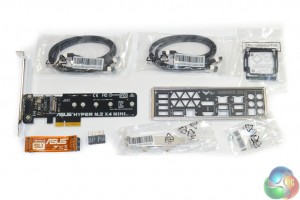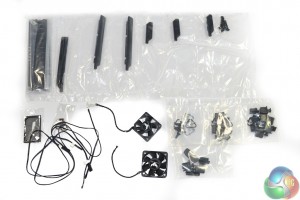Asus ships the Sabertooth Z170 Mark 1 in typical TUF series packaging. A grey box is home to plenty of information relating to the component.
A very healthy bundle is supplied alongside the board, which is positive to see given its premium asking price. The bundle consists of:
- 4x SATA cables
- CPU installation tool
- Rear IO shield
- Q-connector block
- Brown SLI ribbon
- Asus Hyper M.2 x4 Mini PCIe adapter (including half-height PCI bracket and mounting screws)
I am disappointed by the inclusion of an ugly brown SLI ribbon – Asus should know by now that black is the standard for high-end consumer builds. Four SATA cables is also a little irritating given the board's eight SATA 6Gbps connections.
The Hyper M.2 x4 Mini PCIe adapter is an excellent addition as it allows a hot M.2 SSD (such as some of Samsung's NVMe drives) to be installed in an orientation that will provide it with direct airflow from chassis fans. One can also use the adapter to form a RAID array of PCIe M.2 SSDs with the other device being mounted in the onboard M.2 slot.
Asus also supplies a healthy variety of cooling-related hardware. This includes plastic covers for unused slots (which prevent dust entry), three thermal diode cables that can be positioned wherever a user desires, and two cooling fans.
The 40mm fan uses a laptop-style mini fan header and should be installed in the rear IO section (as shown later in the review). The 35mm fan uses a standard 3-pin fan header and mounts in the motherboard's ‘northbridge' location.
The usual affair of product documentation, drivers CD, and case sticker is accompanied by a certificate of reliability which highlights the test processes that the board has passed.
 KitGuru KitGuru.net – Tech News | Hardware News | Hardware Reviews | IOS | Mobile | Gaming | Graphics Cards
KitGuru KitGuru.net – Tech News | Hardware News | Hardware Reviews | IOS | Mobile | Gaming | Graphics Cards







